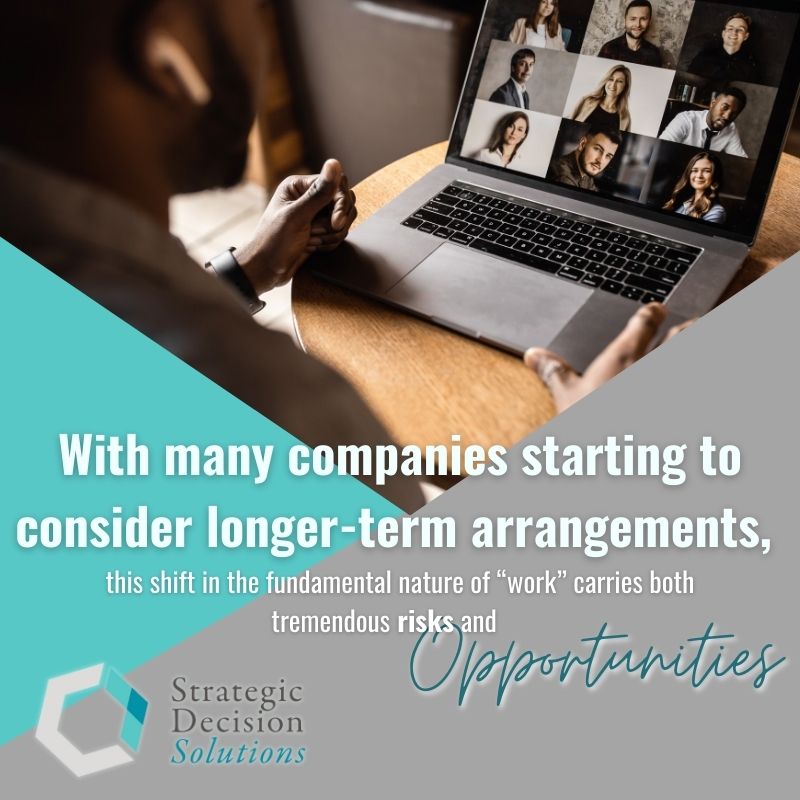When the COVID pandemic forced many companies to shift to a remote work arrangement last year, it represented “…one of the greatest disruptions to work in generations.” This disruption forced both executives and workers to be more innovative, with companies spending over $300 billion last year on technology to facilitate working from home.
The transition was rough as it further blurred boundaries between work and home, but as the year drug on, many employees discovered that working from home did come with perks and flexibility.
For example, a close friend who has been working from home since the beginning of the pandemic has adjusted well and really likes that she can take her lunch time to go to a midday gym class. Another enjoys the fact he can take a 30-minute cat nap in the afternoons.

A theme you hear repeated often (from me and others) is the fact that today’s world is in the throes of an unprecedented level and speed of change. Besides technology, a long-term shift in how we work is the most significant change happening today and one that doesn’t get the attention that it deserves in my opinion.
Some of these changes around “work” are very fundamental in nature, requiring companies to be nimble and adapt on a scale like never before.
Two main issues driving this change in the nature of “work” are:
- Location
It’s clear based on surveys and my personal experience that remote work has its perks, but as with anything, there are drawbacks.
While employees do enjoy the flexibility and no commute, they also miss the collaboration, brainstorming, and human connections you get from being in the office, or as Hannah McCounnaughey, Product Marketing Manager at Microsoft, explains:
Without hallway conversations, chance encounters, and small talk over coffee, it’s hard to feel connected even to my immediate team, much less build meaningful connections across the company.”
And while productivity has remained high for remote workers, lines between work and home have become even more blurred than they were already…a study of Microsoft employees shows nearly half reported working more hours while another (non-Microsoft) survey says 39% of remote workers feel exhausted.
Despite this challenge, it’s clear a significant number of employees would like to continue to work remotely in one way or another. An astounding 87% of U.S. workers in this Morning Consult survey who have been working remotely would like to continue doing so at least one day a week.
This paradigm creates what Microsoft CEO Satya Nadella calls a “hybrid paradox” that requires a shift in not only the work arrangements itself, but also how company leaders define productivity.
- Re-defining the career and what it means to work “full-time”
Another more fundamental issue driving change in the nature of work is a growing skepticism of the idea of the career itself. While it’s a concern shared across all working age groups, it’s most pronounced among younger Millennial and Gen Z workers.
Consider the following…
In a recent jobs survey from Bankrate, 55% of currently employed respondents say they are planning to look for a new job in the next year. Even more astounding is data from the Bureau of Labor Statistics (see below) showing that even in the midst of sharp job losses, just over 2 million quit their jobs voluntarily in April 2020. As of this July, this number stood at a particularly high level of just under 4 million.
It’s difficult to explain the reasoning…some of it may be due to concerns about the virus, but it’s also a reflection of how many are leaving their current jobs to take better opportunities elsewhere.
And by opportunity, I don’t necessarily mean money…
At his “Galaxy Brain” blog, former New York Times chief opinion columnist Charlie Warzel writes:
I don’t know exactly if this energy will keep up but I don’t believe it’s a fluke. The pandemic has left people sick, tired, exhausted, and rattled. It has also changed peoples’ priorities and upended their notions of what is possible.”
In addition to where they work, many employees are taking a harder look at what they want from work, which could mean they would prefer to take less salary if it meant they didn’t have to commit full-time.
How can companies maintain productivity, innovation, and collaboration while meeting the changing needs and preferences of their employees?
It’s clear from this data and countless stories out there that companies must start thinking differently about talent.
Ignoring this reality and simply reverting to a “pre-2020” arrangement will undoubtedly come with significant consequences ranging from “brain drain” and an inability to attract talent to reputational damage, missed goals, and possibly even business failure.
How this applies of course depends on your industry and other factors, so I can’t say you should go hybrid like so many seem to be doing, stay fully remote, or go back into the office full-time. An article we published last year provides some tips on navigating long-term work arrangements along with some questions you can ask.
Many companies are choosing a hybrid route while coming up with innovative solutions to address some of the challenges of remote workers. For example, this Global 100 law firm implemented a “mentoring nest” where 6-8 attorneys gather virtually to discuss their careers; the firm’s leaders hope this interaction will lead to more one-on-one mentoring relationships.
This report and companion whitepaper from Microsoft provides some great tips on how companies can address some of the challenges of a hybrid approach.
Besides location, companies also have to consider what “full-time” even looks like…perhaps you have an employee or two with a hobby-business they’re really passionate about; they would like to commit more time to it, but their full-time day job/career prevents them from doing so. Finding ways to balance this individual preference or situation with the company’s strategic goals and team needs can go a long way toward building the best talent pool, which of course creates a strategic advantage in the process.
How can you find out what employees are looking for? By asking! Whether through a survey, team meeting, or one-on-one conversations, executives should learn what they can about their employees’ needs, preferences, and even their motivations for coming to work outside of putting food on the table.
Overall, executives need to remember these sorts of changes are not like flipping a switch – they will take deliberate effort.
It’s entirely possible some people will leave regardless; after all, that is simply employee turnover. That’s part of the risk you take, which is why evaluating the risks and opportunities and determining if those are acceptable is so important. But the question should be – is your organization positioned to attract the kind of people you want working there?
In the end, it’s not about executives’ preferences, but rather about ensuring the long-term success and viability of the company as a whole.
Companies who leverage this disruption in a risk-informed way will certainly put themselves in a position to “change the name of the game” in their respective industry.
How is your company navigating and adapting to the changing nature of work?
Like I said earlier, this is an all-important topic that I’ll revisit down the road. In the meantime, please feel free to share your perspective on this new reality by leaving a comment below or joining the conversation on LinkedIn.
If your company is experiencing challenges with making this and other adaptations in today’s fast paced world and would like to discuss potential strategies and solutions, click here to schedule a discovery call today!








